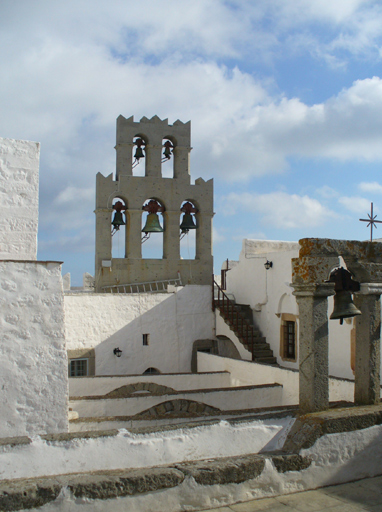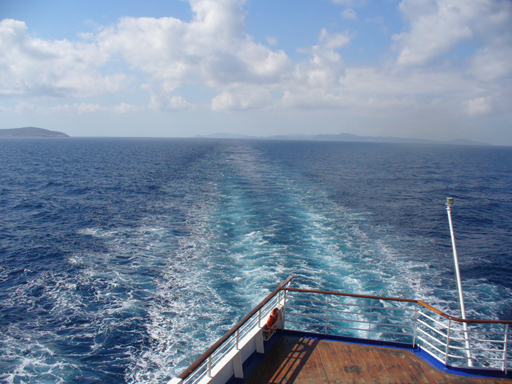HistoryAccording to mythology, Patmos was a present from Zeus to his daughter Artemis, goddess of hunting and young women. She was worshipped here in antiquity, and the monastery of St. John was built on her temple. The island has probably been inhabited since prehistoric times, and it went through the same changes as the rest of the Dodecannese. It paid tribute to Athens in the 5th century BC, belonged to the Macedonians in the 4th century BC, and was taken by the Romans in the 2nd century BC. The Romans used Patmos as a place for exiles, and that's how St. John ended up here. He was ostracized from Miletus by the Roman governor for preaching the Christian faith in AD95, and stayed here for two years. The island was practically deserted during Byzantine years and was given to a monk named Christodoulos in 1088, and he started planning the monastery. In the 11th century the work on the monastery started, and its power was to extend over the island's borders, to such a degree that the island was never occupied by neither Turks nor Venetians. The only attacks came from pirates now and again. In 1912 the island was invaded by Italian forces, and liberated in 1948.
|
Biblical SignificanceThe author of Revelation, the last book of the New Testament, describes himself with these words: "I, John, your brother who share with you in Jesus the persecution and the kingdom and the patient endurance, was on the island called Patmos because of the word of God and the testimony of Jesus" (Rev 1:9).The traditional view of authorship sees John as having been exiled or banished to Patmos by the Roman government on account of his Christian faith. The 4th-century church historian Eusebius reports that John wrote Revelation in 95 C.E., during the time when Domitian was the Roman emperor. According to Eusebius, John was released from the island after the death of Domitian and took up residence at Ephesus. A 5th-century apocryphal writing called the Acts of John by Prochoros
contains legendary stories about the activities of John. According to this
work, John was accompanied to Asia Minor by Prochorus, one of seven
people chosen by the Jerusalem church to assist in the daily distribution
of food (Acts 6:5). In addition to describing other events in the life and
work of John, this work narrates John's exile to Patmos. Prochorus accompanied John there and served as his scribe, recording the visions
dictated to him by John that became the book of Revelation. Although
the story of Prochorus is likely nonhistorical, the traditions are strongly
followed on the island of Patmos.
|
 Early on Palm Sunday morning, our ship docked near the island of Patmos and we were taken by tender to the shore where a bus took us to the Cave of the Apocalypse. Over the entrance to the monastery over the cave is this mosaic of St. John dictating to Prochorus what he had heard.
Early on Palm Sunday morning, our ship docked near the island of Patmos and we were taken by tender to the shore where a bus took us to the Cave of the Apocalypse. Over the entrance to the monastery over the cave is this mosaic of St. John dictating to Prochorus what he had heard.
 We went down a set of stairs...
We went down a set of stairs...

to the entrance of the cave itself.
 A closeup of the icon over the entrance to the cave. Seeing the cave itself was a very emotional experience. Of course, no photography was allowed. I am looking for a photo in the public domain which will give some idea of the cave itself, the niche in the wall where John rested his head, the ledge used as a desk, the threefold crack in the roof of the cave made by the Voice of God according to tradition. I can refer you to photos and further information on websites
here,
here, and
here.
A closeup of the icon over the entrance to the cave. Seeing the cave itself was a very emotional experience. Of course, no photography was allowed. I am looking for a photo in the public domain which will give some idea of the cave itself, the niche in the wall where John rested his head, the ledge used as a desk, the threefold crack in the roof of the cave made by the Voice of God according to tradition. I can refer you to photos and further information on websites
here,
here, and
here.
 We assembled as a group after everyone had seen the cave and Tom read from the Book of Revelation and we had a devotional and prayer.
We assembled as a group after everyone had seen the cave and Tom read from the Book of Revelation and we had a devotional and prayer.
 From the Cave of the Apocalypse we rode the bus further up the hill to the Monastery of St. John. (Photo from a book on Patmos.)
From the Cave of the Apocalypse we rode the bus further up the hill to the Monastery of St. John. (Photo from a book on Patmos.)
 The entrance to one of the chapels at the monastery. (They have ten chapels because church law forbade Mass being heard more than once a day in the same chapel.) We were not allowed inside because it was Sunday.
The entrance to one of the chapels at the monastery. (They have ten chapels because church law forbade Mass being heard more than once a day in the same chapel.) We were not allowed inside because it was Sunday.
 However, we were able to see a service in the narthex of that chapel in the courtyard.
However, we were able to see a service in the narthex of that chapel in the courtyard.
 A bishop was looking at an icon in the narthex while the service was going on.
A bishop was looking at an icon in the narthex while the service was going on.
 The bells of the monastery.
The bells of the monastery.
 From the monastery we could see the port of Skala.
From the monastery we could see the port of Skala.
 We could also see our ship anchored below.
We could also see our ship anchored below.
 We sailed from Patmos to our next destination, the port of Kusadasi and the city of Ephesus.
We sailed from Patmos to our next destination, the port of Kusadasi and the city of Ephesus.
A short cruise from here brought us to Ephesus
